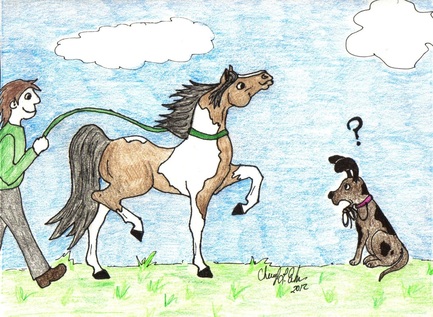 It’s not so unusual, is it? Taking your horse for a walk? Farletta and I do it frequently. However, I have been hand-walking horses since I was a kid. I think it was in part a way to deal with the fear and uncertainty of working with young, green horses when I myself was quite young and green. Walking with the horse may have stemmed from a fear of falling but as I grew older and more connected with the horses in my life I realized there were several benefits to walking with my horse: Unique bonding experience: there is something different about walking with your horse verses riding on top of her – there is a difference in the energy you feel and the connection you have. It is hard to explain; you must experience it. It is not the same as walking your horse to the barn or to the pasture for the purpose of moving him from one place to another; hand-walking your horse is a deliberate activity with the sole intention of spending time with, learning about and bonding with your horse. I enjoy watching Farletta walk next to me – watching how her muscles move smoothly under her skin, the fine arch in her neck, the intricate details of her face and the locomotion of her legs and hooves as they navigate the terrain. Build your horse’s confidence: I have repeatedly encouraged clients and friends to hand-walk a horse for their first trail riding experience. Unfortunately, many do not take the suggestion, over-face their horse (or themselves) and end up having to rebuild confidence of both horse and rider which can be a very long and difficult process. Exposing a horse to a new situation from the ground (vs. from the saddle) is not unlike using ground work to start a horse under saddle –few people use the old “cowboy” method of jumping on and bucking a young horse out anymore as we’ve learned it is much easier on the horse and the rider to slowly expose him to things he must learn to be ridden before you ask him to carry a rider. By removing the rider from a scary situation and instead being a supportive person from the ground, the horse can learn to navigate difficult situations without the added stress of an unbalanced or inexperienced rider. If you are a rider who is nearly impossible to unseat and can approach a scary situation with rock-solid nerves you will likely have success either way. However, if you have a less-secure seat or any anxiety riding a spooky horse, you and your horse will benefit greatly from hand-walking into new situations. When Farletta was young and green I moved her from her home farm in Kentucky to visit another farm for a month. Unlike our home farm, this other farm had nice riding trails and a large outdoor arena. Farletta and my friend’s mare, Phoebe moved together for the month. Farletta had been very calm and quiet at her home farm and seldom spent time with Phoebe. However, when she moved to the new farm she became a different horse. She was nervous and fidgety and would scream when she couldn’t see Phoebe. I had never seen Farletta like this. It was like she had no confidence in her ability to take care of herself. So, I put on her rope halter and a long longe line and took her down the trail. First I led her but gradually I lengthened the line and let her walk ahead until she was leading me. Before she knew it I was behind her and she was in the lead all by herself. She tried to turn back but I encouraged her to continue forward, to be brave and lead me. The strategy worked and soon Farletta was back to her old confident self. Good exercise! I often find it difficult to find the time (or motivation) to go to the gym for a workout. If I put a halter and lead on Farletta and head out to the trails with my dog Boedy off-leash I can exercise all three of us at once! Additionally, it is helpful for Farletta to get used to Boedy crashing around in the woods so that she is confident when we see (or hear) deer and wild turkeys! I make a point of hand-walking Farletta to warm her up before her ride and for the cool-down period. Sure, it’s more work for me but that is the point. Might as well take my calorie burn where I can find it! Ground manners! Lots of people wish their horse’s had better ground manners but few people enjoy working on them. It takes time and effort to get your horse to walk at your shoulder, stop when you stop and go when you go. Does your horse crowd your space? Does he push or pull or refuse to move? Take him down the road (if it’s a safe road!) or down the trail and work on it. It takes a little effort and a lot of consistency but you will never regret the time you spent teaching your horse to respect you and listen to you from the ground. So, grab a halter and lead and hit the trails! Spend some time bonding with your horse. Gain a new outlook and view the trail from your horse’s perspective. You will find a new dimension to your relationship, and increase mutual respect for and trust in one another. Your horse has a gift to offer you; it is the gift of the relationship. We need only to take the time to seek and accept it. Taking a walk with your horse can help you get there. Happy trails!
11 Comments
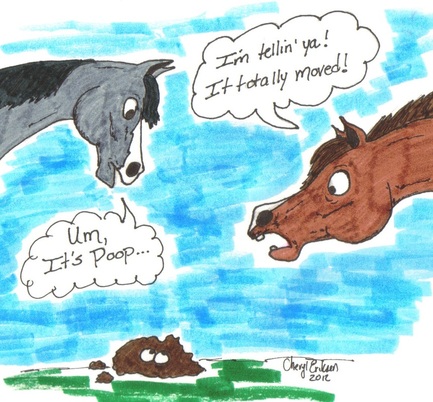 No poop, no horse! We've all heard this at some point in our lives with our four-hooved friends and it's quite true, I can assure you. Many people (myself included) who gag at the thought of changing a dirty diaper or hold your breath and shudder each time you stoop to pick up doggie-doodle don't think twice about slinging horse poo. In fact, we enjoy it...I know I do. Who needs a gym membership? Just give me a manure fork and 20 stalls to clean and I will show you one buff chica! Many horse professionals "break-in" to the horse business slinging poo. Spending hours bent over a fork (one with a full set of tines if you're lucky), cleaning up after our favorite friends is considered a blessing -- "They're actually paying me to hang out with horses! I am so lucky!" I spent many years "paying dues" in the horse business, cleaning stalls for the opportunity to work with horses and develop my skills. In the late 1990s I was working two jobs, seven days a week to make ends meet and support my horse habit. Part of my job was (of course) mucking stalls. On a particulary hot day in early summer I was working away in a stall, sweat rolling off of me from every pore (not that you asked, but yes, it is possible to soak your underwear with sweat). It could have been the long hours, the serious sleep deprivation or the extreme heat...I wasn't sure but one thing I was quite certain of is that one of the pieces of manure had lept from the pile I was working on and landed near the door. I stared in disbelief at the little brown turd trying to decide if I was finally losing my mind. I leaned the fork against the stall wall and wiped my face with my shirt. Just as I was turning back to the fork I caught that turd out of the corner of my eye...it moved again! Now I was positively disturbed. Seriously, jumping poo? I squatted down closer to the magical turd, trying to get a better look in the dim light of the stall. I moved my finger toward it and then, suddenly realizing I was about to touch poo with my bare hand I opted for a nearby piece of hay. I slowly moved the long hay stem toward the poo. Just as I was about to make contact the turd lept again, and again! Right out of the stall and into the barn aisle! I staggered backward in suprise but then quickly followed the jumping poo. I stepped from the stall into the barn aisle. In the brighter light of the aisle I could see the poo was in fact a turd-colored toad which apparantly enjoyed the warmth and moisture of a somewhat fresh pile of manure. "Ha! I knew it! I'm not crazy at all" I said to the turd-colored toad as it hoped down the aisle. I took a swig of cold water and returned to the stall. I looked at the various poo piles, daring them to move, gently prodding them with my fork. They stayed completely still; as all well-behaved manure piles do. I took another drink of water and returned to my work, quite relieved knowing no one had been there to hear me conversing with the "magic poo." ---------------------------------------------- Please give me a "like" at www.facebook.com/PathOfThePeaceHorse! 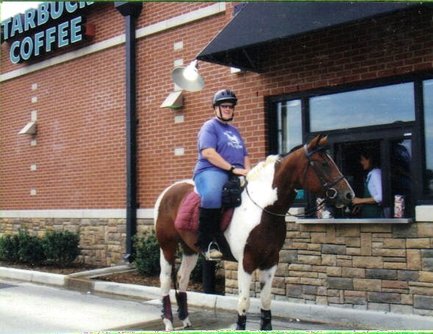 A lot of people ask me about this picture. It was taken at Starbuck's in Paris, Kentucky -- a short 25 minute ride from the over 200-year-old farm where my horse, Farletta and I used to live. When Farletta came to me, she was an unbroken three-year-old. I have always believed the more things you can safely expose a horse to, the more broke, confident and happy that horse will be. Farletta was always a very brave horse, was a pleasure to start under saddle and is a very willing partner. The first time I rode Farletta to Starbucks I went with my friend, Jennifer and her mare Phoebe (older and much more experienced than Farletta). Farletta did great and our Starbucks adventure became a regular occurance that summer of 2007. The Starbucks was located high on a hill, clearly visible from the four lane by-pass leading out of Paris. Without fail, everytime Farletta and I rode through the drive-thru, someone would pull off the by-pass and ask if he or she could take our picture! We always obliged, of course :) ! This is one of my happiest memories with Farletta. Taking her through the Starbucks drive-thru and getting my Grande Caramel Frappuccino! Yum! Farletta didn't drink Frappuccino's but she was glad to recieve some treats, pats on the neck and attention from her new-found fans! We no longer live in Kentucky and unfortunately have no Starbucks within riding distance. However, hopefully someday we will have a chance to again have a Starbucks adventure! I am thankful to my friend Jennifer and her wonderful horse Phoebe, as well as the other friends who made the trip with us, for encouraging us in all our adventures on horseback! Please give us a "like" on Facebook: www.facebook.com/PathOfThePeaceHorse 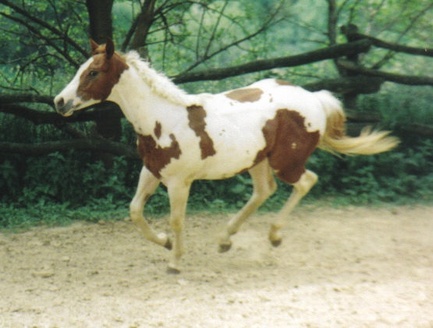 I first met him as a suckling foal. When he came to me for training it was a fuzzy-coated weanling. Tall, lanky and long-eared I fell in love with this colt from day one. There was something about his personality, his willingness to learn, his bravery and his ability to trust so willingly which tugged at my heart. He was a special colt and immediately became my favorite. The spring of his weanling year the colt (whom I'd named Farley) came down with a respiratory infection. Just like with young children, a runny nose and a cough are not cause for serious concern -- we treated Farley and he soon recovered. However, a short time later he came down with another infection, recovered and then took ill again. I spent a lot of time caring for Farley during this time...when he was well, I taught him his first lessons: wearing a halter, leading, tying, picking up his hooves and free-longeing. When Farley was sick I would brush him and talk to him, wipe his nose and give him his medicine. By summer of his yearling year (pictured above), Farley was a strong and healthy stud colt. He was blood-typed as homozygous (meaning he would always produce a patterned foal) which made him a valuable breeding prospect. Farley also had outstanding conformation and was a beautiful, natural mover ideal for western pleasure where they value a slow jog-trot and a natural slow lope (canter). I continued his basic ground training and introduced him to a bit and bridle, the feeling of a surcingle around his body and how to respond to rein pressure. In the late spring of his two-year-old year, I began to introduce Farley to the saddle and to ground driving. He took to it as if he had been driving all his life -- never a buck or objection. He naturally carried his head low and traveled slow and steady. He was beautiful to watch and I marveled at his natural ability. Later that year we introduced him to the weight of a rider -- with absolutely no objection, Farley jogged around the round pen as if he had been broke to ride for years. Farley continued to make progress in his training that year. I was careful not to push him -- it was important to me that he was always calm and happy. In the fall of that year I noticed Farley taking a short step with his right hind leg. He seemed unwilling to bring the leg fully under his body and it seemed to kind of trail along behind him -- just a little bit off the pace. He didn't seem uncomfortable and I could find no heat or pain in the leg so we decided to rest him for a while and see how he went in a month or so. When Farley returned to work he still had that slight short step with his hind leg. He'd drag his toe a bit and was asymmetrical in his movement. I could still find no pain in the leg or in his back or hips. Thinking perhaps he was being lazy, I tried extending his trot -- though he took a longer step, his right hind was still stepping shorter than the left hind. I consulted with Farley's owner and we decided to take him to the vet for a full work-up. The vet performed a few neurological tests and Farley tested positive for potential neurological damage. The vet suspected Equine Protozoal Myeloencephilitis (EPM). At that time (2000) the only way to determine if Farley had EPM was to do a spinal tap. I left Farley at the vet so they could anesthetize him in the morning and perform the spinal tap. The test results came back as positive for EPM. EPM is a parasitic attack on the horse's spine impacting the central nervous system. A horse with EPM will lose feeling in the affected area of the spine and the limbs associated with that area. This is why Farley was not using his leg properly -- he could no longer feel it. In 2000, EPM was considered a career-ending and possibly life-ending disease. If the parasite could not be stopped, it would eventually follow the spine into the brain and kill the horse. There was a very expensive, time-consuming, messy treatment which had had minimal success. In most EPM cases, if any improvement was made it was often short-lived and the horse never regained proper use of the affected legs. There was also a strong incidence of relapse. Farley's owners opted to treat his EPM. The vet was optimistic as Farley was only two-years-old and we had caught it relatively early. Farley began as six-month treatment where he was give 60cc of gooey paste in his mouth, three times a day. He could not eat four hours before or two hours after his medicine. For six months Farley (a young stallion) was on stall-rest and minimal food intake. He became very skinny and his muscles wasted away but he survived the treatment and beat the EPM. He is pictured below about a month after his treatment ended. 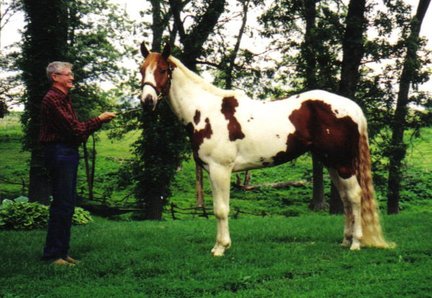 Farley had recovered from his EPM but he still did not have proper use of the right-hind leg. The nerve damage could not be repaired and he did not have full feeling in that leg. Farley was a three-year-old stallion with tons of potential but no show record to prove it. It seemed he would never be able to show as he would always appear lame in his movement. However, I was unwilling to give up on my favorite horse. I developed my own system to try to help him regain proper use of his leg. I started by free-longeing him in a large round pen asking him to trot faster than his normal western jog. He trotted faster but his stride was short and choppy; especially the right-hind leg. I found some long pieces of hedge wood outside and used them as ground poles. I started with them close together and slowly moved them further apart, forcing him to take a longer stride. After a few months he was taking noticeably longer steps AND his short-stepping right hind leg was moving better than ever! Before and after his workouts I stretched Farley's hind legs forward and backward trying to increase his range-of-motion. I massaged his back, loins and hips hoping to stimulate his nerves somehow. In the spring of 2002 Farley was four-years-old and much stronger than he had been the year before. I started riding him again (huntseat this time), using the ground poles to encourage him to take longer steps. I worked him in a "long and low" frame to strengthen his topline. Occassionally I put the western saddle on him so I could dally a rope to the horn and have Farley drag some heavy tires around the arena to build his strength. By late spring (a year after his EPM treatment ended) Farley was using his right hind leg properly again and there was no asymmetry in his gait. As long as I kept his hind-end engaged and his back lifted into a proper frame, Farley was totally normal. The owner was pleased...it was time to take Farley to his first show! Farley's first show was June 2002. He won both huntseat classes and both western pleasure classes! Later that year he earned his first APHA points at the Paint Horse futurity! I was so proud of my boy! I was unwilling to give up on my friend and we worked hard together to beat the odds and return a "ruined" EPM horse back to full health and athletic ability! Farley taught me to never give up no matter how steep the odds. I believed in him and he trusted me -- together, we prevailed. Below are some pictures of Farley and I at his first show. I once met a man who is blind. We were discussing what it was
like to be a blind person in a sighted world. This man was an advocate for the blind and worked as a consultant to help businesses and other public facilities become more accessible for persons who are visually impaired. For the most part he found businesses were happy to make needed accommodations such as adding braille to signs throughout the building. However, he found some businesses to be quite resistant to making any changes at all saying it was much too expensive to make accommodations. One business owner told him it was simply too expensive to accommodate blind employees. The man replied with a chuckle "it is interesting to hear how expensive it is to accommodate the blind with a few raised bumps on a sign but no one ever complains about how much it costs to light an entire building for the sighted." Yesterday I co-facilitated an EAP/L workshop at the Sundance Center in Fennville, Michigan. One topic which came up in processing our activities was how difficult it can be for us to view the world from another person's perspective; especially if this person is very different from us. In EAGALA model EAP/L we focus on the art of "clean language" -- asking a question with as little judgment as possible. A "clean" question has very few words such as: "How was that?" Words which carry any judgment are removed and/or changed to clean words: "How did the horse feel when you hit him with the pool noodle?" becomes "What happened when the pool noodle touched the horse?" The idea is to be curious, not judgmental in our questioning. Can you see the judgment in the first question? If someone asked you that question would you feel like you were in trouble or did something wrong? The point is the first question is being asked to "confirm" what the facilitaor already (thinks) "knows." The second question is being asked because the asker truly wants to know what is going on. The lesson here in our EAP practice is to ask questions with genuine curiosity and without judgment. This takes lots of practice and requires a shift in our thinking. As you interact with people in practice and in your life, think about the words you choose…are you coming from a place of curiosity and empathy or are we unintentionally (or consciously) coming from a place of judgment and egocentrism? |
AuthorCheryl L. Eriksen, MSW, Equine Enthusiast, EAGALA groupie and writer of interesting, educational and entertaining blog posts! Archives
April 2021
|
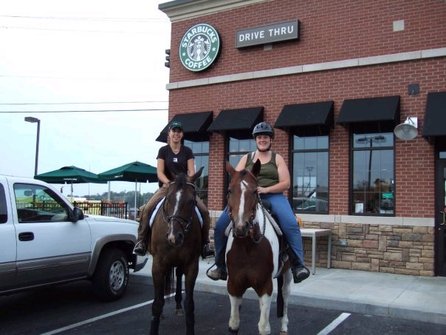
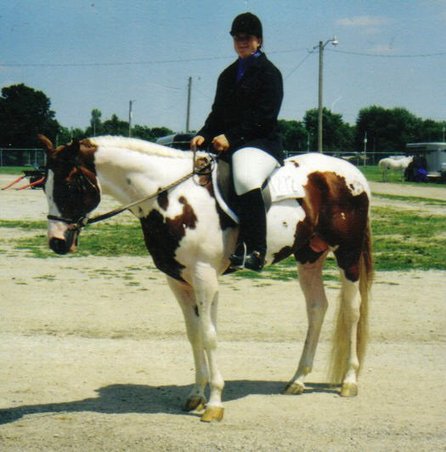
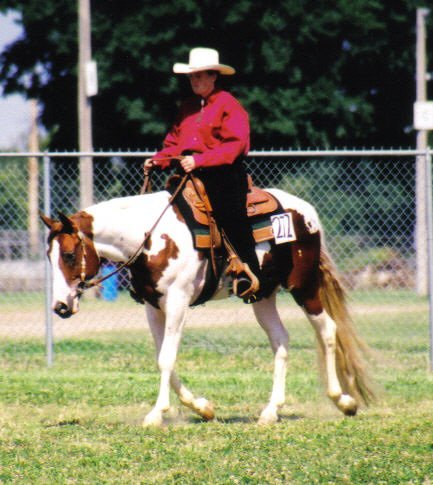
 RSS Feed
RSS Feed
